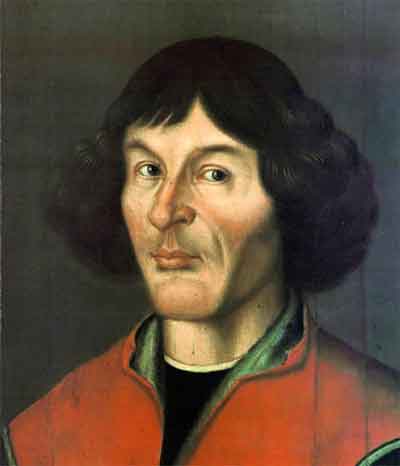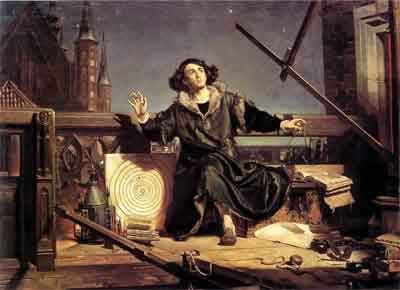 |
usa | world | animals | vocabulary | health | science | math | history |
Copernicus

Nicolaus Copernicus (portrait from Toruń - beginning of the 16th century)
Mikołaj Kopernik (February 19, 1473–May 24, 1543), more commonly known by the Latin form Nicolaus Copernicus, was a Polish astrologer, astronomer, mathematician and economist, mainly remembered for developing a scientifically useful heliocentric (Sun-centered) theory of the solar system. His main occupations and services rendered were in Royal Prussia, as church canon, governor and administrator, economist, jurist, physician, astrologer and military leader (conducting defense against the Teutonic Order). Amid all his responsibilities, he treated astronomy as a hobby. His theory about the Sun as the center of the Universe, opposed to the traditional geocentric theory that placed Earth at the center, is considered one of the most important discoveries ever, and is the fundamental starting point of modern astronomy and modern science itself (it inaugurated a scientific revolution). His theory affected many aspects of human life, opening the door for young astronomers, scientists and scholars to take a skeptical attitude toward established dogma.
Copernicus was born in 1473 at Toruń (Thorn) in Polish Royal Prussia. Copernicus was ten when his father, a wealthy businessman and copper trader, died. Copernicus' maternal uncle, Lucas Watzenrode, a church canon and later Prince-Bishop governor of Warmia, reared him and his three siblings after the death of Copernicus' father. In 1491 Copernicus enrolled at the Jagiellonian University in Kraków, and here for the first time encountered astronomy, thanks to his teacher Albert Brudzewski. This science soon fascinated him, as shown by his books (later carried off as war booty by the Swedes during The Deluge, and now at the Uppsala University Library). After four years at Kraków, followed by a brief stay at Toruń, he went to Italy, where he studied law and medicine at the universities of Bologna and Padua. His bishop-uncle financed his education and wished for him to become a bishop as well. However, while studying canon and civil law at Ferrara, Copernicus met the famous astronomer, Domenico Maria Novara da Ferrara. Copernicus attended his lectures and became his disciple and assistant. The first observations that Copernicus made in 1497, together with Novara, are recorded in Copernicus' epochal book, De revolutionibus orbium coelestium.
In 1514 he made his Commentariolus — a short handwritten text describing his ideas about the heliocentric hypothesis — available to friends. Thereafter he continued gathering evidence for a more detailed work. In 1533 Albert Widmanstadt delivered a series of lectures in Rome outlining Copernicus' theory. By 1536 Copernicus' work was already in definitive form, and some rumors about his theory had reached scientists all over Europe. From many parts of the continent, Copernicus received invitations to publish, but he feared persecution for his revolutionary work by the establishment. Cardinal Nicola Schoenberg of Capua wrote, asking him to communicate his ideas more widely and requesting a copy for himself; "Therefore, learned man, without wishing to be inopportune, I beg you most emphatically to communicate your discovery to the learned world, and to send me as soon as possible your theories about the Universe, together with the tables and whatever else you have pertaining to the subject." Some have suggested that this note may have made Copernicus leery of publication, while others have suggested that the Church wanted to ensure that his ideas were published..

"Astronomer Copernicus: Conversation with God" painted by Jan Matejko (1872).
Copernicus' major theory was published in the book, De revolutionibus orbium coelestium (On the Revolutions of the Heavenly Spheres) in the year of his death, 1543, though he had arrived at his theory several decades earlier.
The book marks the beginning of the shift away from a geocentric (and anthropocentric) universe with the Earth at its center. Copernicus held that the Earth is another planet revolving around the fixed sun once a year, and turning on its axis once a day. He arrived at the correct order of the known planets and explained the precession of the equinoxes correctly by a slow change in the position of the Earth's rotational axis. He also gave a clear account of the cause of the seasons: that the Earth's axis is not perpendicular to the plane of its orbit. He added another motion to the Earth, by which the axis is kept pointed throughout the year at the same place in the heavens; since Galileo Galilei, it has been recognized that for the Earth not to point to the same place would have been a motion.
Copernicus also replaced Ptolemy's equant circles with more epicycles. This is the main source of the statement that Copernicus' system had even more epicycles than Ptolemy's. With this change, Copernicus' system showed only uniform circular motions, correcting what he saw as the chief inelegance in Ptolemy's system. But while Copernicus put the Sun at the center of the celestial spheres, he did not put it at the exact center of the universe, but near it.
This article is licensed under the GNU Free Documentation License. It uses material from the Wikipedia article "Copernicus".